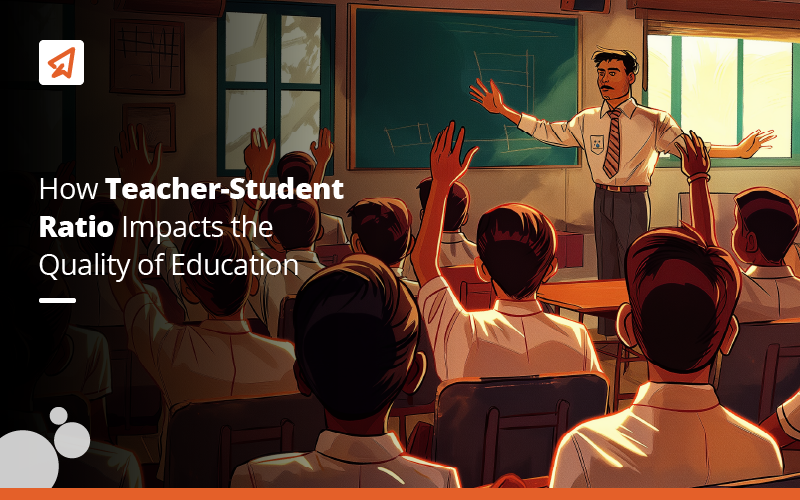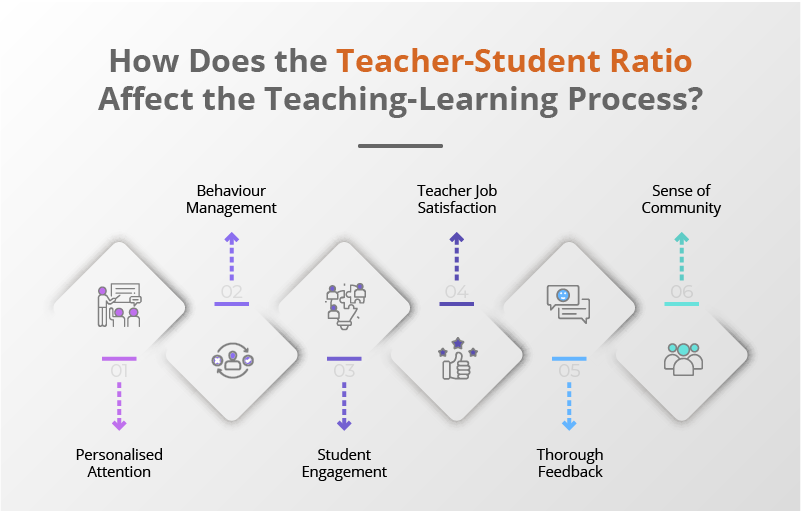How Teacher-Student Ratio Impacts the Quality of Education?

When you visualise a classroom, you think of teachers imparting knowledge, dozens of students listening with rapt attention, notes being scribbled in margins, and bags and books occupying every free inch of space available. But we often notice how a teacher may try and fail to claim the attention of all the students. Is it because they are a bad teacher? Or are they bad students? Or is it because of the many students teeming in each classroom? The latter is most often the closest to the truth – the teacher-student ratio is not apt.
When students are abundant, and teachers are scarce, a classic demand and supply problem arises. On the other hand, if we imagine a classroom with fewer students, we can visualise how they would blossom because not only would they be learning, but they would feel seen, and their intellectual and developmental needs would be met in a personalised and individualistic manner.
In most cases, this teacher-student ratio is a crucial factor for instilling life-long lessons and development for most children.
What is a “Teacher-Student Ratio”?
A teacher-student ratio simply means the proportion of students per teacher in a single class. So, if there are 20 students in a class, then the student-teacher ratio will be 20:1.
This is not the same as the average class size, even though both statistics are related. The teacher-student ratio also refers to the amount of workload a teacher has with managing a certain number of students, and how much time, effort, customisation and mentoring they can provide to one single student. The larger the number of students present in one classroom, the more the attention of the teacher is fractioned.
So, if a classroom has 30 students, then a teacher can only contribute 3.3% of their interest to one child at any given point in time! The teacher isn’t able to give adequate attention and focus to a singular student, and this always affects the students as the teacher-student ratio is directly proportional to a student’s capacity to perform.
What is a Good Student-Teacher Ratio?
There are no specific figures that stipulate the ideal student-teacher ratio. For each school, it is a subjective figure, depending on the budget allowances, the total number of admissions, and the number of teachers currently employed.
Generally, a rule of thumb is that the lower the teacher-student ratio, the better. Some experts believe that a ratio as low as 10:1 is the ideal ratio for a classroom setting in a day school. Several boarding schools believe in promoting lower-than-normal ratios, which will guarantee one-on-one mentoring for the children, along with the teachers being free to alter the curriculum and instructional methods depending on the needs and learning styles of the learners.
In India, the Right of Children to Free and Compulsory Education (RTE) Act, 2009, elaborates on its recommended student-teacher ratio (also referred to as the pupil-teacher ratio or PTR) for both primary and upper primary schools. At the primary and upper-primary level, the PTR should be 30:1 and 35:1 respectively. The Rashtriya Madhyamik Shiksha Abhiyan (RMSA) framework also stipulates that the PTR at the secondary level of schooling should be 30:1.
Contrary to this, the PTR at a national level for elementary schools and secondary schools, according to UDISE (Unified District Information System for Education), is 24:1 and 27:1.
The consensus among all sources and experts is that a lower teacher-student ratio is the ideal way to go. Sometimes, due to budget restrictions and the lack of availability of good, qualified teachers, especially for public schools, this is not possible for several institutions within the country.
How Does the Teacher-Student Ratio Affect the Teaching-Learning Process?

As mentioned above, the teacher-student ratio is directly proportional to the quality of the education a child receives and how the child performs. A lower student-teacher ratio is the ideal, utopian figure, and it has several tangible benefits in the long run, throughout the school journey. A few aspects that are directly affected by the student-teacher ratio are mentioned below.
- Personalised Attention: The higher the teacher-student ratio, the lower the amount of personalised attention given to each student. As much as the teacher may try, they are only human. In a high-ratio classroom, students who may need assistance or attention for their special weaknesses or strengths go unnoticed, which is detrimental to their future development. The teacher simply would not have the time to focus individually on each child. In a classroom with a lower student-teacher ratio, the teacher will also have the freedom to adapt the instructional and testing methods to suit the needs of each child, making learning a fun experience, not a tough one.
- Behaviour Management: In a classroom with a lower teacher-student ratio, the teacher will easily be able to observe disruptive behaviour. More often than not, disruptive behaviour stems from a lack of understanding or a lack of interest. In a classroom with a high student-teacher ratio, such actions would often be brushed off as attention-seeking behaviour. But, when the number of students is less, the teacher can work with the student and get to the root of the issue, and make them feel understood and seen.
- Student Engagement: Often when teachers ask students to volunteer to present and interact with the entire class, students tend to feel shy or embarrassed. In a classroom with an ideal student-teacher ratio, students will be more inclined to speak up and participate. They will feel more comfortable asking doubts and voicing their opinions.
But, an ideal student-teacher ratio is not as achievable as it sounds. In the recent decade, there has been a dramatic increase in admissions to private schools. In this education era, administrators find themselves at a loss due to the sheer numbers, and the teacher-student ratios tend to remain high in the best of institutions. The numerical density of students is far higher than the number of available teachers, and this often impacts student engagement and interaction within classes.
A trend has been observed in schools to adopt various educational tools to counter this high-ratio environment and make classes more interactive and engaging, such as audio and video presentations, collaborative group projects, and smart class aids such as the Extramarks’ Smart Class Plus. With Extramarks, you can provide quality education rather than quantity education, with engaging activities like pop-up quizzes, interactive simulators and brain-teasers.
- Teacher Job Satisfaction: Teachers who work in lower teacher-student ratio classes tend to report a higher level of job satisfaction. Teachers in such low-ratio classes think as if they are making a much more significant impact on the lives of their students. They feel like they have the freedom to mentor and guide the kids, mould the curriculum to fit their specific needs and address any concerns, both academic and life-related. Teachers have more time to ensure complete conceptual understanding and intellectual development.
- Thorough Feedback: In classes with ideal teacher-student ratios, teachers find it easier to manage classes and maintain decorum. Feedback from the educator and the learner is much more detailed. Both strengths and weaknesses can be identified and worked upon. The issues outlined by the feedback can easily be rectified, and it creates a general environment of growth and support for the students and the academicians.
- Sense of Community: A lower teacher-student ratio means a more tight-knit classroom environment, where the students are much closer to each other and often consider each other like family. A smaller class size leads to increased interactions, a development of trust, and a sense of overall support during learning hours. Students will collaborate more and learn to depend on one another for peer reviews and help with problem areas.
An ideal learning environment is one where students absorb and retain the information they are taught. Being able to actively interact with each other, collaborate, ask questions and solve doubts, is all part of the educational journey they embark on. Teachers have to act as guides and pave the path towards a successful learning experience. A teacher-student relationship can only be fostered if the teacher-student ratio is conducive to that. While a lower ratio is always better, at the end of the day, what truly matters is how deeply the teacher impacts the lives of the students they teach, whether it’s 10 or 100!
Last Updated on February 14, 2025
Reviewed by

Prachi Singh | VP - Academics
Prachi Singh is a highly accomplished educationist with over 16 years of experience in the EdTech industry. Currently, she plays a pivotal role at Extramarks, leading content strategy and curriculum development initiatives that shape the future of education...read more.










